At 19, Jama Adam was a star engineering student at the University of Hargeisa who dreamed of building a better Somaliland. People described him as calm, focused, and destined for great things. But after his friends invited him to chew khat—a popular social activity—during Eid celebrations in June 2019, Jama's aspirations took a backseat.
The green leaves gave Jama a buzz that he craved and eventually he found himself chewing khat every day. He began spending his allowance on khat rather than his university fees and chewing khat rather than studying. He failed exams, missed classes, and within two years, at 21, the university expelled him.
"I lost everything," he said. "My education, my family's trust, my dreams. All for the leaf." Today, he spends his days in a local mafrish (khat house).
Stories like Jama's are common in Somaliland, where the youth unemployment rate is near 70%. Without economic opportunities, many young men use khat as a pastime. In Hargeisa, Somaliland's capital, khat houses are filled with young men, like Jama, who spend hours chewing the leaves.
Khat's influence on Somaliland spans mental health, chronic disease, household economics, and cultural life. Addressing it requires balancing tradition with urgent public health needs. Regulation, education, investment in health care, and youth employment initiatives offer a realistic path forward.
How Khat Harms Health
Khat is a widely consumed recreational drug in the Middle East and the Horn of Africa, derived from the leaves of the Catha edulis. Chemically, it is structurally similar to amphetamine, noradrenaline, and MDMA (ecstasy). Its primary active compounds are cathinone and cathine. For centuries, khat has been used in social gatherings and by religious men to stay awake for prayer for centuries, but in Somaliland, its use among young men has exploded.
83% of individuals who consumed khat heavily reported severe mental disabilities exhibited by psychotic symptoms
Despite its pervasive presence in the culture, no comprehensive, population-level studies on the actual prevalence of khat use have been conducted in Somaliland. News reports and extensive on-the-ground observations indicate that up to 90% of adult males and 5% of females regularly chew the stimulant. The effects can be harmful. Research links excessive khat use to severe mental health issues, including anxiety, depression, and psychosis.
A study in Hargeisa found that 83% of individuals who consumed khat heavily reported severe mental disabilities exhibited by psychotic symptoms. Binge chewing (more than two bundles a day) is also strongly correlated with the onset of paranoia and hallucinations. Another study from eastern Ethiopia notes that chronic khat use disrupts sleep, worsens mood, and can lead to dependence, pulling users into a cycle in which they chew to cope with the very distress khat creates.
Khat also contributes to the growing burden of noncommunicable diseases. The 2020 Somaliland Demographic and Health Survey [PDF] reported high rates of hypertension (41%), diabetes (19%), and cardiovascular diseases (7%) among the population; khat use was identified as a factor. A 2023 hospital study in Hargeisa found that 20.4% of participants chewed khat. Among them, 53.5% reported grade 1 hypertension and 36.4% reported prehypertension. Although the study found no women who consumed khat, this result may speak more to the social stigma against the practice for women—and the subsequent underreporting—than to its actual absence.
Research from other countries supports the relationship between khat use and noncommunicable diseases. A study from Jazan, Saudi Arabia, suggests khat use increases the risk of type 2 diabetes fourfold; meanwhile, studies in East Africa link consumption to cardiovascular complications, stroke, and oral cancers. In Somaliland, the absence of cancer screening in hospitals likely conceals the full extent of khat-related cancers.
The Economics of Khat
Khat's role in Somaliland's economy is both beneficial and damaging. Thousands of families, including many women vendors, depend on the crop for income. In 2014, tax on khat sales generated 20% of Somaliland's $152 million budget. The trade supports jobs from Ethiopian farms to urban street stalls.

Although the khat industry provides government revenue, this benefit is offset by significant economic drawbacks. Somaliland spends an estimated $180 million each year on khat imports from Ethiopia, draining its foreign currency reserves. Furthermore, household spending on the stimulant is extremely high. A survey in Hargeisa found that families spend up to one-third of their total income [PDF] on khat, often prioritizing it over other essential needs. This widespread consumption, combined with the government's reliance on khat revenue, complicates any efforts at regulation, especially given that its use is common among public officials and security forces.
Cultural Considerations
In Somaliland, khat chewing sessions are central to social and political life. These gatherings, known as mafrishes, serve as informal forums where business deals are struck, community disputes are mediated, and political strategies are debated. They reinforce male social bonds, tradition, and hospitality.
But this cultural institution has a dark side. Women's groups cite studies indicating a strong link between khat use and intimate partner violence. The connection is often driven by the financial strain when household funds are spent on the drug and by domestic neglect resulting from men spending long hours away from home. The stimulant's effects, such as increased irritability during the comedown phase, are also seen as a contributing factor to conflict. This financial pressure is often worsened when remittances sent by the diaspora for family support, such as school fees or rent, are diverted to fund the habit.
Religion's influence on khat use is also complex, and Islamic leaders remain deeply divided on its permissibility. Proponents argue that because khat is not explicitly forbidden in the Quran as alcohol is, it is permissible (halal) [PDF], comparing it to stimulants like coffee. Conversely, other scholars argue that it is forbidden (haram) by using analogical deduction (qiyas). They contend that khat violates the core Islamic principle of avoiding harm given its proven negative effects on health, family stability, and personal finances, making it comparable to other prohibited substances. Despite this ongoing debate, the stimulant remains widely consumed.
Banning khat outright, as some Western countries have done, however, isn't feasible given its entrenchment in the local culture and the economy. Instead, Somaliland could start with regulation. Some advocates have suggested [PDF] limiting import times or setting age restrictions to curb overuse without collapsing the trade. Public health campaigns, using local voices targeting youth, could raise awareness about the risks of khat. Schools and mosques could lead these efforts, framing khat as a health issue, not just a moral one
Investing in mental health care is necessary. Chronic khat use is linked to severe mental illness because its psychoactive compounds, cathinone and cathine, alter brain chemistry. This can lead to persistent psychosis, paranoia, anxiety, and depression. An estimated 80% to 90% of Somalis do not have access to quality mental health services, leaving the health-care system unequipped to manage khat-related psychiatric disorders. The government's 2022 sin tax on khat, which raises funds for mental health, is a start.
Prevention through economic opportunity is also essential. Evidence shows a correlation between youth unemployment and substance abuse. A lack of viable jobs can lead to hopelessness, making the escape offered by khat more appealing. For young men like Jama, chewing the substance can become a coping mechanism. Programs that create opportunities, such as vocational training and small business grants, are a vital part of the solution. They provide young people with a stake in their future and a sense of hope.
Without action, more young people like Jama will see their futures diminished, one bundle at a time.













